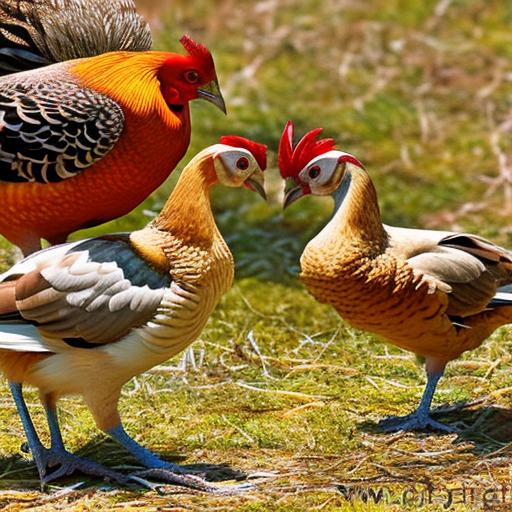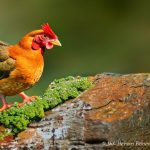Keeping turkeys and chickens together is a practice that has gained popularity among backyard poultry enthusiasts. It involves raising both turkeys and chickens in the same flock, allowing them to coexist and interact with each other. While turkeys and chickens are different species, they can be successfully kept together with proper management and care. This article will explore the benefits, challenges, and considerations of keeping turkeys and chickens together.
There are several reasons why someone might want to keep turkeys and chickens together. One reason is increased flock diversity. By having both turkeys and chickens in the same flock, you can enjoy the variety of different breeds and colors. This can add visual interest to your flock and make it more enjoyable to observe. Additionally, having a diverse flock can also provide genetic diversity, which can be beneficial for overall flock health and resilience.
Another reason to keep turkeys and chickens together is improved pest control. Turkeys are known for their foraging abilities and can help control pests such as insects, slugs, and snails. They have a keen eye for spotting small creatures on the ground and can quickly gobble them up. By allowing turkeys and chickens to forage together, you can create a natural pest control system that benefits both species.
Key Takeaways
- Keeping turkeys and chickens together is possible and can have benefits.
- Raising turkeys and chickens together can lead to better pest control and socialization.
- Turkeys and chickens have different needs and behaviors that should be understood.
- Housing should be spacious and secure to accommodate both species.
- Feeding should be balanced and appropriate for both turkeys and chickens.
Benefits of Raising Turkeys and Chickens Together
One of the main benefits of raising turkeys and chickens together is the more efficient use of space and resources. Turkeys are larger birds compared to chickens, so they require more space to roam and forage. By allowing them to share the same space with chickens, you can maximize the use of your available land. The chickens can utilize the lower areas while the turkeys can explore higher ground.
Additionally, turkeys have a different feeding behavior compared to chickens. While chickens primarily scratch at the ground for food, turkeys prefer to browse on vegetation and insects. By allowing them to forage together, you can ensure that both species have access to a wider range of food sources. This can lead to healthier and more balanced diets for both turkeys and chickens.
Understanding the Differences Between Turkeys and Chickens
Before deciding to keep turkeys and chickens together, it is important to understand the physical and behavioral differences between the two species. Turkeys are larger and more robust compared to chickens. They have a different body structure, with a longer neck and larger wingspan. Turkeys also have a different vocalization, with their famous gobbling sound.
In terms of behavior, turkeys are generally more curious and adventurous compared to chickens. They are known to be more active and enjoy exploring their surroundings. Chickens, on the other hand, tend to be more docile and prefer to stay close to their coop. These differences in behavior can impact flock dynamics when turkeys and chickens are kept together.
Housing Requirements for Turkeys and Chickens
When keeping turkeys and chickens together, it is important to provide adequate housing that meets the needs of both species. Turkeys require more space compared to chickens due to their larger size. A general rule of thumb is to provide at least 10 square feet of space per turkey, while chickens can thrive with around 4 square feet per bird.
Both turkeys and chickens require nesting areas for laying eggs. Turkeys prefer to nest on the ground, while chickens prefer elevated nesting boxes. Providing separate nesting areas for each species can help prevent conflicts and ensure that both turkeys and chickens have a comfortable place to lay their eggs.
Protection from predators is also crucial when housing turkeys and chickens together. Turkeys are more vulnerable to predators due to their larger size, so it is important to have secure fencing and housing that can keep out potential threats. Additionally, providing roosting areas at different heights can help accommodate the different preferences of turkeys and chickens.
Feeding Turkeys and Chickens Together
Feeding turkeys and chickens together requires careful consideration of their nutritional needs. Turkeys have higher protein requirements compared to chickens, especially during their growing phase. It is important to provide a balanced diet that meets the nutritional needs of both species.
One strategy is to provide a high-quality poultry feed that is formulated for both turkeys and chickens. This can ensure that both species receive the necessary nutrients for optimal growth and health. Additionally, offering supplemental treats such as fruits, vegetables, and insects can provide enrichment and variety to their diet.
It is important to monitor the feeding behavior of both turkeys and chickens to ensure that each species is getting what they need. Turkeys tend to be more dominant when it comes to feeding, so it may be necessary to provide separate feeding areas or feeders to prevent bullying and ensure that all birds have access to food.
Health Concerns When Keeping Turkeys and Chickens Together

When keeping turkeys and chickens together, there are certain health concerns that need to be addressed. Both species can be susceptible to certain diseases, some of which can affect both turkeys and chickens. It is important to implement proper biosecurity measures to prevent disease transmission.
One common disease that can affect both turkeys and chickens is avian influenza. This highly contagious viral disease can cause severe illness and death in poultry. It is important to practice good biosecurity measures such as regular cleaning and disinfection of housing, limiting contact with wild birds, and monitoring for any signs of illness.
Another disease of concern is blackhead disease, which primarily affects turkeys but can also be transmitted to chickens. Blackhead disease is caused by a microscopic parasite called Histomonas meleagridis. It can cause severe damage to the liver and intestinal tract, leading to high mortality rates in turkeys. Preventive measures such as regular deworming and proper sanitation can help reduce the risk of blackhead disease.
Managing Flock Dynamics Between Turkeys and Chickens
Managing flock dynamics between turkeys and chickens is crucial to ensure a harmonious coexistence. Turkeys and chickens have different social structures and hierarchies, which can lead to conflicts and aggression if not properly managed.
Establishing a pecking order is a natural behavior in poultry, where individuals establish their rank within the flock. This can involve pecking, chasing, and other aggressive behaviors. It is important to provide enough space and resources to minimize competition and reduce the likelihood of aggressive behavior.
One strategy for managing flock dynamics is to introduce new birds gradually. This allows them to establish their place within the flock without causing too much disruption. It is also important to monitor the behavior of individual birds and intervene if necessary to prevent bullying or injury.
Preventing Disease Transmission Between Turkeys and Chickens
Preventing disease transmission between turkeys and chickens is essential for maintaining a healthy flock. Implementing proper biosecurity measures can help reduce the risk of disease spread.
One important biosecurity measure is to limit contact with wild birds, as they can carry diseases that can be transmitted to poultry. This can be done by providing secure fencing and netting to prevent wild birds from entering the poultry area. It is also important to regularly clean and disinfect housing and equipment to minimize the risk of disease transmission.
Quarantine procedures should also be implemented when introducing new birds to the flock. This involves isolating new birds for a period of time to monitor for any signs of illness before introducing them to the rest of the flock. This can help prevent the introduction of diseases that may be carried by new birds.
Tips for Successful Integration of Turkeys and Chickens
Integrating turkeys and chickens successfully requires careful planning and management. Here are some tips to ensure a smooth integration:
1. Introduce new birds gradually: When introducing new birds to the flock, it is important to do so gradually. This allows the birds to establish their place within the social hierarchy without causing too much disruption.
2. Provide enough space and resources: Ensure that there is enough space and resources for all birds to minimize competition and reduce the likelihood of aggression. This includes providing multiple feeding areas, nesting areas, and roosting spots.
3. Monitor behavior and intervene if necessary: Keep a close eye on the behavior of individual birds and intervene if necessary to prevent bullying or injury. This may involve separating aggressive birds or providing additional resources.
4. Practice good biosecurity measures: Implement proper biosecurity measures to prevent disease transmission. This includes regular cleaning and disinfection of housing, limiting contact with wild birds, and monitoring for any signs of illness.
Is Keeping Turkeys and Chickens Together Right for You?
Keeping turkeys and chickens together can be a rewarding experience for backyard poultry enthusiasts. It offers benefits such as increased flock diversity, improved pest control, and more efficient use of space and resources. However, it also comes with challenges such as managing flock dynamics and preventing disease transmission.
Before deciding to keep turkeys and chickens together, it is important to carefully consider the needs of both species and ensure that you have the necessary resources and knowledge to provide proper care. By understanding the differences between turkeys and chickens, providing appropriate housing and nutrition, implementing good biosecurity measures, and managing flock dynamics, you can create a successful and harmonious mixed flock.
If you’re considering keeping turkeys and chickens together, it’s important to understand the dynamics and requirements of both species. To help you make an informed decision, Poultry Wizard has a comprehensive article on their website that explores the topic in detail. This article provides valuable insights into the compatibility of turkeys and chickens, as well as tips on how to create a suitable environment for them to coexist harmoniously. To learn more, check out their article on keeping turkeys and chickens together.
FAQs
Can turkeys and chickens be kept together?
Yes, turkeys and chickens can be kept together in the same coop or pen.
Do turkeys and chickens get along?
Turkeys and chickens can get along, but it depends on the individual birds and their personalities. Some turkeys may be aggressive towards chickens, while others may be more docile.
What are the benefits of keeping turkeys and chickens together?
Keeping turkeys and chickens together can provide companionship for both species and can also help with pest control in the coop or pen.
What are the potential problems of keeping turkeys and chickens together?
Turkeys and chickens have different dietary needs, so it is important to make sure they are both getting the proper nutrition. Additionally, turkeys may be carriers of diseases that can be harmful to chickens.
What should I consider before keeping turkeys and chickens together?
Before keeping turkeys and chickens together, consider the size of your coop or pen and make sure there is enough space for both species. Also, research the dietary needs of both turkeys and chickens to ensure they are both getting the proper nutrition. Finally, monitor the birds closely for any signs of aggression or illness.
Meet Walter, the feathered-friend fanatic of Florida! Nestled in the sunshine state, Walter struts through life with his feathered companions, clucking his way to happiness. With a coop that’s fancier than a five-star hotel, he’s the Don Juan of the chicken world. When he’s not teaching his hens to do the cha-cha, you’ll find him in a heated debate with his prized rooster, Sir Clucks-a-Lot. Walter’s poultry passion is no yolk; he’s the sunny-side-up guy you never knew you needed in your flock of friends!







